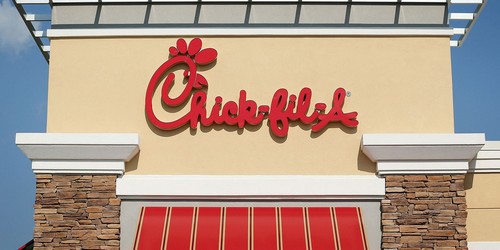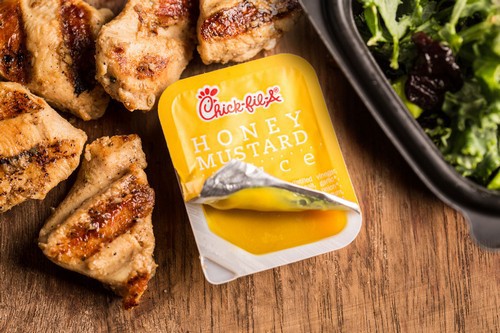The Marketing mix of Chick-fil-A analyses the 4Ps of Chick-fil-A, including the Product, Price, Place, and Promotions. Chick-fil-A is associated with the food and beverage industry as it deals in the fast-food sector. It is a private company of American origin and was founded in 1946 by its founder, S Truett Cathy. Chick-fil-A is a subsidiary of its parent company, Cathy Family. The brand is well-poised in this highly competitive market but still faces competition from the following-
- Subway
- Burger King
- McDonald’s
About Chick-fil-A
- Type: Fast food restaurant chain
- Industry: Quick-service restaurant
- Founded: 1946
- Founders: S. Truett Cathy, Ben Cathy
- Headquarters: College Park, Georgia, United States
- Area served: 48 states, the District of Columbia, and Puerto Rico
- Current CEO: Dan Cathy
- Number of employees: 27,000 (2022)
- Major products: Chicken sandwiches, chicken nuggets, waffle fries, salads, milkshakes, and desserts
Table of Contents
Chick-fil-A Product Strategy
Chick-fil-A is a fast-food restaurant chain specializing in sandwiches made from chicken. The joint serves breakfast, lunch, and dinner menus and offers unique event-catered selections.
Chick-fil-A is a famous American fast-food chain known for its specialized product mix focused primarily on chicken-based items.
The new Product Mix of Chick-fil-A in 2023 is as follows (Source).
- Chicken Sandwiches: The flagship product is the Chick-fil-A chicken sandwich, which comes in various forms, including the classic sandwich, the spicy version, and grilled options.
- Chicken Nuggets and Strips: Besides sandwiches, the chain offers chicken nuggets and strips, which are famous for their flavor and quality. These are available in different portion sizes and can be ordered with various dipping sauces.
- Breakfast Items: Chick-fil-A’s breakfast menu includes chicken biscuits, egg sandwiches, and breakfast burritos featuring chicken as a primary ingredient.
- Salads: Chick-fil-A offers several salad options for health-conscious customers, often incorporating chicken as a protein source. These salads are known for their fresh ingredients and variety.
- Sides: The side menu includes items like waffle fries, fruit cups, side salads, mac and cheese, and yogurt parfaits, providing a range of options to accompany the main meal.
- Beverages and Desserts: The selection includes soft drinks, lemonades, iced teas, and milkshakes. The chain also offers desserts, primarily its famous cookies and ice cream.
- Sauces and Dressings: Chick-fil-A is known for its unique range of sauces and dressings, often praised for their flavor. These include the Chick-fil-A sauce, Polynesian sauce, and various salad dressings.
Chick-fil-A’s product mix is designed around its core competency of chicken-based fast food, and the company is known for its consistent quality, friendly service, and clean restaurants. Despite a relatively focused menu, they maintain a strong market position by doing a few things exceptionally well.
Chick-fil-A Place Strategy
Chick-fil-A operates mainly in Canada and the United States. Its headquarters are based in Atlanta in the United States. The brand has opened nearly 2,500 restaurants throughout its home country, including forty-six states. The first Chick-fil-A restaurant was opened at Greenbriar Mall in Atlanta, and with time, the company opened its restaurants in other locations like Manhattan, New York City, and Columbia. Its first foray into the overseas market was in 2014, with a restaurant at Calgary International Airport in Calgary, Canada.
Chick-fil-A has a unique way of operating. It selects a location and then builds a restaurant over there. The company retains ownership, but as it believes in a franchise system, it offers the interested operator a chance. He has to make an initial payment of ten thousand US dollars and go through a training program to become eligible to handle the store. The franchise owner must pay Chick-fil-A 50% of the net profit as part of its business dealings.
Chick-fil-A built its first freestanding franchise in Atlanta, Georgia. The company has opened drive-through-only joints at thirty-one locations, and most of its restaurants can be found at airports, hospitals, universities, and malls. Chick-fil-A has created an outstanding presence in the online sector and hence offers online delivery and order placements.
Here’s the place strategy of Chick-fil-A.
- Strategic Location Selection: Chick-fil-A carefully selects its restaurant locations, prioritizing high-traffic areas such as shopping malls, college campuses, and busy city streets. This ensures maximum visibility and accessibility to a broad customer base.
- Stand-Alone Restaurants and Drive-Thru Focus: Most of Chick-fil-A’s locations are stand-alone restaurants with drive-thru services, catering to customers seeking quick and convenient meal options. The drive-thru model has become increasingly important, especially for on-the-go consumers.
- Limited International Presence: While predominantly a U.S.-based chain, Chick-fil-A has started expanding internationally, which is still a tiny part of its overall strategy. These international locations help gauge global market potential and brand reception.
- Closed on Sundays: A unique aspect of Chick-fil-A’s place strategy is its policy of closing all locations on Sundays. This decision, rooted in the company’s values, sets it apart from competitors and has become a well-known aspect of its brand identity.
- Selective Expansion Approach: Chick-fil-A adopts a cautious and deliberate expansion strategy, focusing on sustainable growth rather than rapid expansion. This approach allows them to maintain high standards of quality and service in new locations.
Chick-fil-A Pricing Strategy
At the end of the 2016 financial year, Chick-fil-A posted its revenues at 8 billion US dollars. It has targeted middle and upper-middle-class people from urban families as its target customers looking for quick-serving fast-food joints with good quality offerings. Chick-fil-A is an established brand with a lot of credibility. It faces stiff competition from several rival brands.
The company has adopted a reasonable pricing policy that keeps its products affordable. To deal with its competitors, the company has adopted a competitive pricing policy and has kept its product prices at par with the prices maintained by its rival brands.
Chick-fil-A’s pricing strategy is a critical component of its business model, balancing the need to offer value to customers while maintaining its reputation for quality and service. Here’s an overview of their approach:
- Premium Fast Food Pricing: Chick-fil-A positions itself as a premium fast-food chain, with prices slightly higher than typical fast-food restaurants. This pricing reflects the high quality of ingredients, preparation methods, and overall customer service experience the brand is known for.
- Value Meals and Combo Offers: The brand offers value meals and combo deals, bundling items like sandwiches, sides, and drinks at a reduced price compared to purchasing items separately. This strategy appeals to budget-conscious customers, providing a complete meal at a perceived discount.
- Dynamic Pricing Based on Location: Prices at Chick-fil-A can vary based on location to reflect local market conditions, such as rent and labor costs. This geographical pricing ensures competitiveness and profitability in different markets.
- Catering and Bulk Orders: Chick-fil-A provides catering services with a separate pricing structure, catering to groups and events. This includes bulk orders, which offer a convenient solution for larger gatherings, often at a price point representing savings over individual purchases.
- Psychological Pricing Tactics: Like many fast-food chains, Chick-fil-A employs psychological pricing strategies, such as setting prices just below a whole number (e.g., $4.99 instead of $5.00). This tactic makes prices appear more affordable and can encourage additional spending.
- Limited Time Offers and Promotions: The chain occasionally introduces limited-time offers and special promotions strategically priced to create excitement and attract customers. These can include seasonal items or new product introductions, often priced attractively to encourage trial.
This multifaceted pricing and marketing strategy alone allows Chick-fil-A to balance providing value, maintaining its high-quality standards, and achieving business profitability. This approach is central to its position as a leading player in the competitive fast-food industry.
Chick-fil-A Promotion Strategy
Chick-fil-A has adopted an innovative technique to publicize its brand and its products. It has created ad campaigns that have dealt with a direct impact on customer mindset. As part of its promotional activity, the company offers a free meal to people who come dressed as a cow on their annual Cow Appreciation Day. Its descriptive taglines like ‘We didn’t invent chicken sandwich chick or the Chicken, Just the Chicken Sandwich,’ and ‘Eat Mor C,’ skin are very popular.’
Chick-fil-A created a video called ‘Running of the Cows’ and started the Best Cow Costume Photo contest via its website to promote brand visibility. All its ads are unique and enjoyable. The fast food company also has utilized social media platforms to its full advantage and maintains a strong presence via Twitter, YouTube, and Facebook pages.
Chick-fil-A has entered into several sponsorship deals to increase its brand visibility. It has become the title sponsor of The Peach Bowl and is the key sponsor of ACC and SEC college athletics. The company organizes a high school basketball tournament at Columbia and a charity tour by motorcycle every year. Chick-fil-A offers food service during some of the events it organizes.
It actively participates in over seven hundred programs like children’s homes, needy families, and academic scholarships. The brand has received several awards, such as the Consumer Choice Award for its many fresh products and healthy food items.
Some Recent Video ads and Print ads for Chick-fil-A are:
Liked this post? Check out the complete series on Marketing Mix

